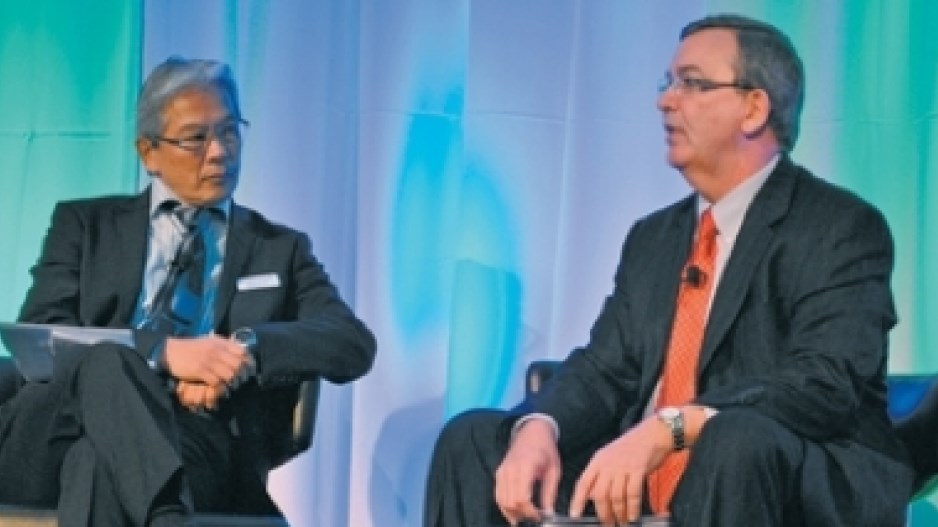BC Hydro is facing "unprecedented uncertainty" in its future electricity requirements due to extraordinary growth in industrial development.
That was the message from Doug Little, BC Hydro's vice-president of energy planning and economic development, to attendees at Clean Energy BC's annual conference, Generate 2013, in Vancouver last week. But, large-scale growth notwithstanding, he said the Crown corporation will be able to meet domestic generation needs until the early 2020s.
BC Hydro's draft Integrated Resource Plan (IRP) – its long-term energy roadmap, published in August – supports Little's assertions. Power Smart, BC Hydro's conservation program, new electricity from contracted but yet-to-be-completed independent power projects (IPP) and Site C, the $8 billion hydroelectric dam planned for northeast B.C., were to shoulder any increase.
The report stated that no new green energy projects – IPPs – would be needed for another decade. But the IRP, which will be re-submitted to the government by November 15, will be changing after Energy Minister Bill Bennett directed BC Hydro last week to revise its IRP to include more green energy.
Bennett's directive was good news for conference attendees, the majority of whom own independent power companies that sell power to BC Hydro.
Andrew Weaver, Green Party MLA for Oak Bay-Gordon Head, applauded Bennett's move, but criticized the draft IRP, which he believes was written with a political slant.
"You don't write an IRP in a month. [BC Hydro] assumed it was going to be an NDP government, and the NDP had been critical of IPPs," said Weaver. "Then the Liberals won."
In an interview after his talk at the conference, Little maintained BC Hydro can provide the electricity needed in the province for the near future.
"BC Hydro can meet domestic needs until the early 2020s," said Little.
After 2022, however, there are "gaps."
An example of those gaps may be the years between Site C's completion, expected in 2024, and the build-out of the liquefied natural gas industry.
Final investment decisions on LNG export facilities are expected by 2015 or 2016.
BC Hydro forecasts a 400% load increase to power the northeast natural gas processing that will supply the facilities on the coast. Little added that, by comparison, BC Hydro's typical annual load increase has been between 1% and 2%.
To service that massive jump, it commissioned the Dawson Creek/Chetwynd Area Transmission Line, which is expected to be in use in early 2015. But more is needed. Little said BC Hydro is considering a second transmission project in the area but offered no details or a timeline for its completion.
BC Hydro expects large LNG facilities to use natural gas to run the compressors needed to cool the gas. But it will have to provide electricity for the ancillary needs of the plants such as lights and control systems.
BC Hydro's longstanding support of Site C as the key supplier to satisfy future generation needs caught the ire of some in attendance at the conference. Clarence Willson, a councillor with the West Moberly First Nations, on whose traditional land in the Peace Region Site C is planned, said the project will "devastate" important hunting land and ecosystems in the area.
"There is nothing safe or renewable about Site C," said Willson. •
Study on impact of run-of-river projects on salmonids set for December release
The first comprehensive assessment on the effects of run-of-river projects on salmonids will be published in December, according to the Pacific Salmon Foundation (PSF), the organization conducting the report.
According to Brian Riddell, PSF president and chief executive officer, 44 run-of-river sites from across British Columbia were examined for the study. The analysis of each site was broken into three parts: the upstream reach, the portion of river leading up to the dam of a run-of-river project, the diversion reach, the section of the river between the dam and the powerhouse where water is rerouted and the downstream reach, the section where the water returns to the river.
Researchers are attempting to determine if the pathway of a run-of-river project alters the travels of salmonids and whether salmonids are exposed to stressors because of the change in stream. Salmonids in the study include chinook, coho, chum, pink and steelhead.
"This report is critical to the credibility of the clean energy sector," said Paul Kariya, executive director of Clean Energy BC.
The study cost $300,000 and was funded by the Gordon and Betty Moore Foundation, the Living Rivers Trust Fund and Clean Energy BC.




